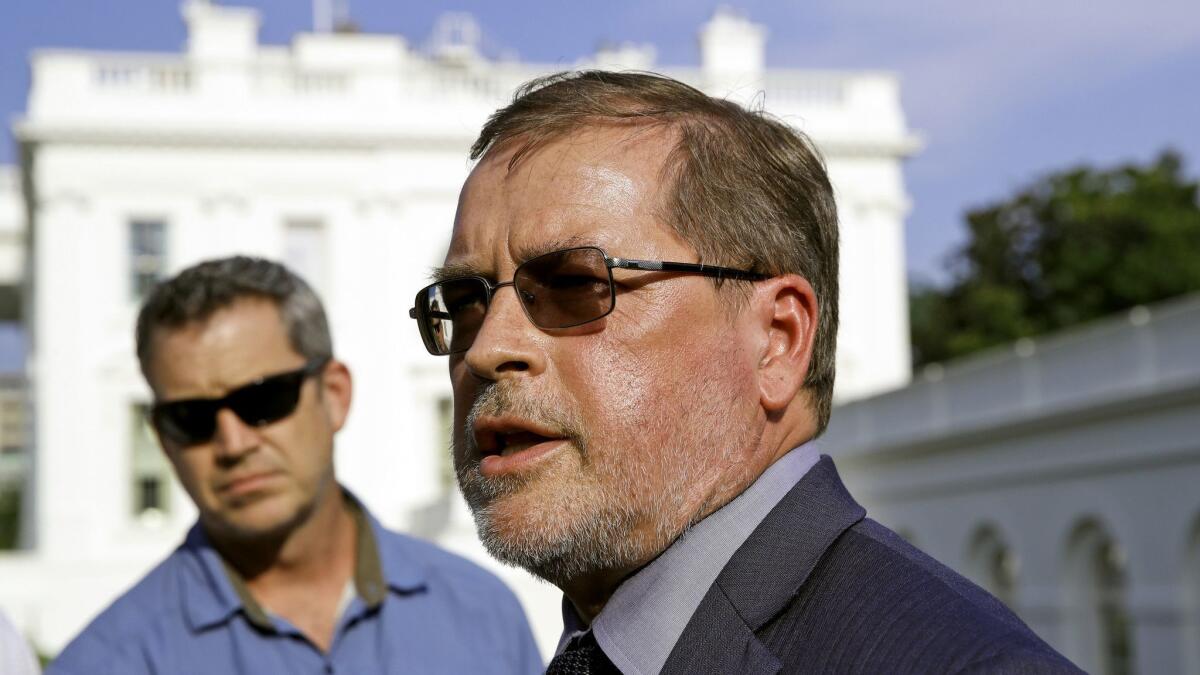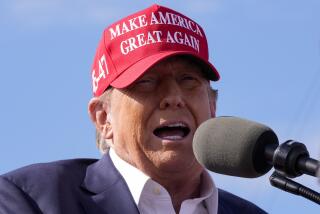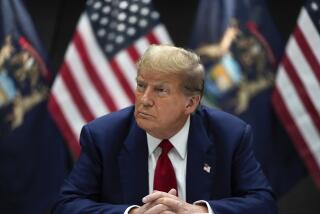Column: Conservative anti-tax groups ask Trump to give the rich another tax cut by executive fiat

Some people are never satisfied. That goes double for America’s 1%, especially when it comes to tax breaks.
Not content with the enormous tax cut they received from President Trump and the Republican-controlled Congress in December 2016, they’re now angling for an additional tax cut. Even worse, they’re proposing that Trump circumvent the Democratic majority in the House of Representatives by giving it to them via executive fiat.
The proposal is embodied in a letter to Trump issued Tuesday by 41 anti-tax and right-wing organizations. They include current or former affiliates of the Koch brothers’ network such as the American Legislative Exchange Council (ALEC) and the Club for Growth; Grover Norquist’s Americans for Tax Reform; the American Conservative Union, which is chaired by Matt Shlapp, husband of Trump White House aide Mercedes Shlapp; and the Heartland Institute.
Taking bold executive action now — without having to go to Congress — will restore confidence in financial markets.
— Anti-tax groups’ appeal for another tax cut
Their target is the capital gains tax, the tax rate of which already is significantly lower than the tax rate on ordinary income such as wages and salaries. Their beef is that the tax isn’t indexed for inflation. That can be a significant component of capital gains, they assert, especially for capital assets that have been held for decades. The argument is that inflation produces a “phantom gain” that shouldn’t be taxed.
The groups cite a finding by “the non-partisan Tax Foundation” that “fully one-third of all unrealized capital gains are due only to inflation.” They take a stab at labeling this component the “inflation tax.” The Tax Foundation, by the way, might be nominally nonpartisan, but it’s been heavily funded by the Koch brothers. They argue that the president has the authority to define the “cost” of a capital asset — that is, the amount over which the tax is calculated — in terms that include inflation.
Let’s take a look at the two main issues raised by the letter — whether capital gains taxpayers are unfairly charged for inflation, and whether Trump has the unilateral authority to index the capital gains tax for inflation.
The answer to the first question is no. Capital gains taxpayers already receive huge tax breaks compared with ordinary working stiffs that should more than compensate them for inflation.
To begin with, the rates on capital gains are much lower than those on wages and salaries. The top rate is 20%; compared with a top rate on wages and salaries of 37%. Even if one adds the 3.8% tax on unearned or investment income imposed on those with income over $250,000 (for married taxpayers filing jointly), that rate is still roughly only two-thirds of the rate on earned income — in other words, roughly the amount of gains the Tax Foundation says is due to inflation.
Moreover, the 2016 tax cut already indexed the capital gains tax to inflation, if indirectly. It did so by establishing three brackets for capital gains rates, and indexing them to inflation. For the 2018 tax year, taxpayers earning up to $77,201 pay a 0% tax on capital gains. Those with income from $77,201 to $479,001 pay 15%, and everyone earning more pays the 20% rate. For 2019, those brackets will be higher by about 2% — the rate of inflation. (The dollar figures are for joint filers.)
That’s not the end of the tax giveaway on capital gain. As Ed Kleinbard, the ace tax analyst at USC, explains, the capital gains tax is our only voluntary tax. It’s incurred only when a capital asset is sold. But stockholders and other beneficiaries don’t ever have to sell their assets; they can bequeath it to their heirs, who then benefit from the “step-up” in basis on inherited assets — they’re pegged to their value at the time of inheritance.
In other words, say someone bought a stock at $1,000 in 1970, and today it’s worth $100,000. That’s an embedded capital gain of $99,000. But if the taxpayer leaves it to his or her heirs, they would pay tax only on its value over $100,000 when they sold it. The embedded capital gains tax is extinguished forever.
Nothing prevents the original owner from enjoying the fruits of the investment in the meantime. He or she can borrow against the higher value or use derivatives to capture the gains without selling the asset. Nice deal.
As we’ve reported before, the capital gains break is the quintessential rich person’s boon. On average, in 2016 (the last full year for which figures are available) taxpayers reporting income of $10 million or more claimed nearly 54% of their income as capital gains or dividends subject to the low rate; only 17.5% of their income was reported as wages or salary. For a middle-class taxpayer reporting income in the $75,000-$100,000 range, about 76% was wages and salary taxed at ordinary rates, and only 2% qualified as capital gains and qualified dividends.
That brings us to the presidential authority to index capital gains taxes to inflation. Here the picture is murkier, but the weight of expert opinion is that the authority doesn’t exist. Even beyond that, the indexing advocated by the conservative groups would needlessly complicate tax calculations.
That was the conclusion of economist and historian Bruce Bartlett in 2012. (Bartlett, a White House advisor to Ronald Reagan and George H.W. Bush, has since become a very effective critic of conservative economic policies.) In his 2012 article for Tax Notes, Bartlett noted that the idea of indexing capital gains by executive fiat had been examined during the first Bush administration by the Treasury and Justice departments, both of which concluded it was not lawful. By the way, the attorney general at the time was William Barr, who has been nominated to the same post by Trump.
Bartlett added that the move could cause a political firestorm by stepping on the legislative authority of the House Ways and Means and Senate Finance committees in Congress, which “tends to jealously guard its prerogatives.” One might add that the spectacle of a president giving a new handout to the ultra-rich by unilateral decree would probably not do much for his popularity.
Bartlett also pointed to the complexity of an inflation index for capital gains, starting with: which inflation index to use? Every index, such as the consumer price index, has its imperfections. Congress has worked around these by settling for endowing capital gains with a preferential tax rate, at least some of which is designed to compensate for inflation.
Despite the discouraging conclusions of the 1990s, conservatives never have tired of the inflation-indexing dream, perhaps because the one human sentiment that knows no boundaries is greed. The groups urging this course on Trump muster the same tired claim they’ve used to justify every other tax cut for the rich — that it will produce economic growth — despite the lack of evidence that tax cuts have that effect.
They say, “Taking bold executive action now — without having to go to Congress — will restore confidence in financial markets and help bolster every 401(k), IRA, and 529 plan in America,” donning the misleading mantle of populism. They’re full of it. This is a giveaway to the rich, and Trump buys into it at his political peril.
Keep up to date with Michael Hiltzik. Follow @hiltzikm on Twitter, see his Facebook page, or email michael.hiltzik@latimes.com.
Return to Michael Hiltzik’s blog.







